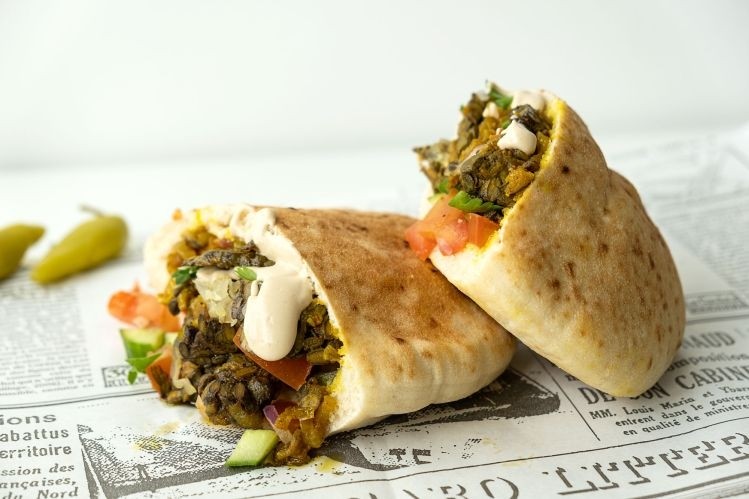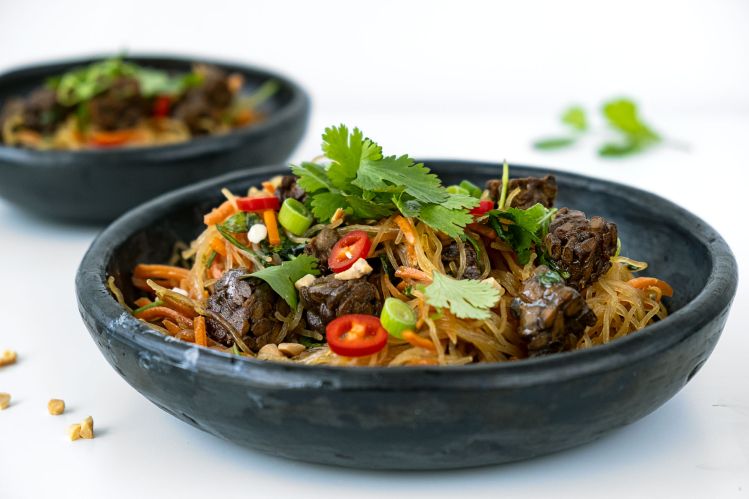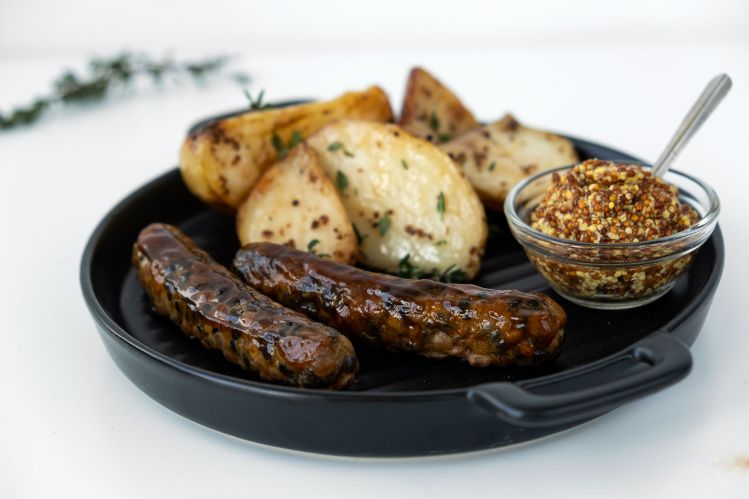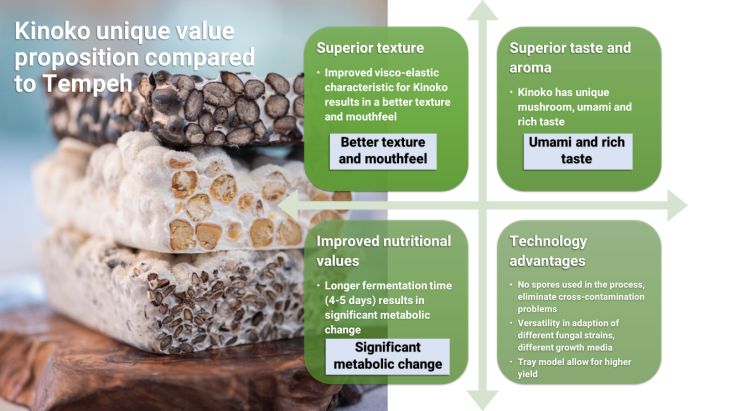Meat-free: Kinoko harnesses solid state fermentation to offer high-protein, minimally processed center-of-the plate options

Kinoko is creating minimally processed foods that can be used in everything from stir fries and burritos to burgers and salads, with a clean label (eg. soaked black lentils and quinoa, the name of the fungi strain, and salt) said co-founder and CEO Dr Jasmin Ravid.
"It’s basically traditional fermentation, not precision fermentation [like that used by Perfect Day or The EVERY Co] and not biomass fermentation [like Quorn or Meati Foods]," said Dr Ravid, who founded the firm in 2019 with Dr. Daria Feldman (CTO), and Hadar Shohat (COO).
“We are taking edible plant-based ingredients – legumes and grains in their raw form - and we are adding fungi mycelium on top and they undergo a transformation. So we’re taking something already healthy like lentils, which people don’t know how to cook and aren’t a complete protein, and turning them into a complete protein food that can be used as a drop-in replacement for animal foods, a main dish.”

Taste, texture, nutrition changes: More complex flavor, juicy texture, higher protein, lower carbs
During the fermentation process, which lasts around four days, the fungi are added to the lentils or grains (which must first be soaked in water and heated, and sit in trays that look like cupcake trays with a little pile of lentils/grains in each one) and start to work their magic, altering texture, taste, and nutrition, she explained.
“When the fungi is growing on the lentils it creates this bouncy, juicy texture, and it transforms the taste from something between the legume to a mushroom, so it’s a much more rich, umami flavor.
“On the nutritional value, the fungi eat away most of the carbohydrate – breaking it down into simple sugars and burning them, reducing the glycemic index, and elevating the protein content, but also transforming the protein into a complete protein. The protein is also more bioavailable as the fermentation disintegrates anti-nutrients in the legumes.
“The end product also has beta glucans which are very beneficial to health, and create a feeling of fullness, so our foods are very satisfying.”
The fungi/legume or grain combo can grow in any shape or form, she said, depending on the shape and dimensions of the trays it grows in, so could be grown into burgers, meatballs, strips, or chunks and so on without requiring additional expensive downstream processing.
“You end up with an end product that you can take out of the fridge and throw straight into your stir fry.”
‘Really the only thing we need to do is to keep the temperature stable at about room temperature’
Unlike some players in the rapidly growing precision fermentation space (that use synthetic biology to program microbes to express proteins that then need to be extracted from the broth or from the cells themselves), or those growing fungal biomass in liquid suspension, Kinoko does not require expensive stainless steel fermentation tanks, but a series of stacked trays with lids, explained Dr Ravid.

“Every unit is separate to prevent the chance of cross contamination, and really the only thing we need to do is to keep things stable at about room temperature. There is no need for lighting or a need to control moisture. This is the real strength of the platform."
'I consider it more like indoor agriculture [than food processing]'
She added: “It's much cheaper [than using fermentation tanks] and we can basically use any food facility infrastructure and use off the shelf equipment, so I consider it more like indoor agriculture [than food processing].”
After the product is ready, Kinoko then freezes it and can distribute it to third parties, who can sell it frozen, although some partners want a chilled product, so Kinoko is now working on packaging options enabling firms to receive a frozen product and then sell it in the chilled aisle with a shelf-life of 90-days.
Regulatory pathway and go to market strategy
Kinoko has already completed the self-affirmed GRAS (Generally Recognized as Safe] process for its foods, and is planning to seek a ‘no questions’ letter from the FDA, said Dr Ravid, who is currently operating from a pilot facility in Rehovot, Israel, from which she hopes to start supplying a small amount of product in Q2 2023 when she gets approval from Israeli regulators.
“Right now, we are designing the next production site, which will be a fully commercial production site something between 20 to 50 tons per month," she explained.
"We already have a strong design partner in Israel that we are working on a commercial agreement with, and we are going to start selling to them in Israel. And then once we have the bigger production site, we want to start up in markets outside of Israel, both the US and Europe.”
As for the business model at Kinoko, which now has 11 full-time employees, she said, “We are a b2b company, but it’s not exactly just an ingredient [it could also be a standalone CPG product, such as a tray of meatballs], so we can do private label products for retail or supply it as an ingredient [that would go into mixed dishes] for CPG or foodservice. Whether it will be private label or co-branding, we're open to both, it’s under discussion with every company.”
She added: “We’ll start with meatballs for consumers to cook at home, but we are now discussing with other partners outside of Israel how it could be used in ready-to-eat meals, meatballs that are marinated and so on.”
One particularly appealing aspect of the meatballs is how well they retain their structure during cooking, said Dr Ravid, who has raised $3.5m to date.
“We know this is a huge problem for some plant based foods, as when you cook them in sauce they can disintegrate, because the extruded proteins cannot last with heat. With our product, it just stays intact.”

‘We have this amazing food that people love, and it’s healthy and tasty. But how do we communicate it because it's something new?’
But what about marketing and messaging? How do you describe what Kinoko is doing to consumers and to potential customers in a way that is appealing and easy to understand?
According to Dr Ravid: “It’s one of the main things we’ve been thinking about since starting the company, kind of okay, we have this amazing food that people love, and it’s healthy and tasty. But how do we communicate it because it's something new?
“We will definitely want to communicate that it's lentils and mushrooms, but how we will talk about fermentation will depend on the country we’re targeting, as each country has its own conception of fermentation.”
That said, she noted, “The main thing we will try to get consumers to understand is how clean and natural it is, that it is not processed, it only has four ingredients and it has amazing nutritional value.”
The innovation pipeline
To date, Kinoko has focused on lentils and quinoa, but the technology also works with peas, chickpeas and various beans, she said. “We are also looking at upcycling side streams from the tofu industry or oatmilk or from plant protein isolate production so we can build a more circular economy.”
As for the fungi strains, she said, “our fermentation platform works with many strains of fungi, and we experiment with several. Still, at the first step, we will only commercialize products based on one strain of fungi for regulation reasons. Each fungi strain requires a regulation process of its own. Our GRAS only applies to the strain we are now commercializing.”
As for IP, she said, “we have a strong patent that protects the end product's fermentation process and unique texture. It is now entering the international phase.”
To readers wondering if Kinoko is basically making tempeh and calling it something different, Dr Ravid told us: "Unlike tempeh, our platform supports fermentation with different strains of fungi. Therefore, we are not limited to working with Rhizopus as in tempeh.
"The fungi we use and a longer fermentation time give our products a completely different taste and texture than tempeh. So, it might look very similar, but nobody eating our product has ever thought he is eating tempeh. Our extended fermentation period also allows significant transformation in nutritional value to accrue. Lastly, we have many technological advantages in our scale-up structure compared to traditional tempeh production."














